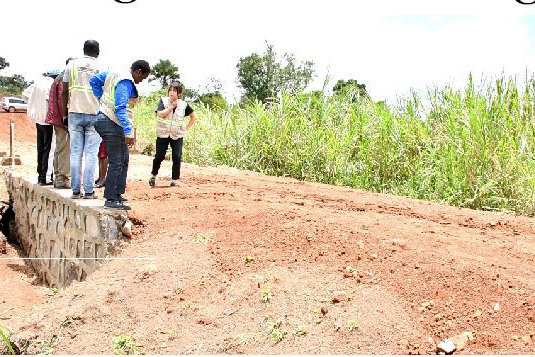Prime
Gulu locals using new technology to fix roads

Gulu District leaders and staff of Japanese NGO, CORE, inspect Unyama Bridge at Awonyim Village, currently being fixed by residents using the Do-nou technology on September 27. PHOTO/TOBBIAS JOLLY OWINY
What you need to know:
- Mr Samson Mukiibi, an engineer with CORE, said: “Whereas a kilometre of the conventional road refurbishment method costs approximately Shs80m in villages, the Do-nou constructed road costs about Shs30 million, and the project will end in March 2025.”
Leaders in Gulu District are scaling up a new technology for road repairs in which residents fix potholes and broken bridges using hand-held tools.
Last Wednesday, the officials commissioned a previously impassable Onyama Bridge that connects Awonyim and Akwi villages in Patiko Sub-county.
Ms Francesca Atoo, the senior environment officer for Gulu, said since the district and sub-counties most times do not have enough funds to hire machinery to fix community access roads, Do-nou technology is a viable alternative.
“Our next move is now to scale the technology to the rest of the district because when you visit many parts of the district, the roads are impassable and key bridges are broken. School children suffer the most,” Ms Atoo said.
She added: “This method makes it very easy for us to move into the community and identify the people to be trained and they work on the roads cheaply.”
Ms Atoo said leaders approved use of the new technology in Patiko and Owoo sub-counties since they are the most affected in the district.
“They had very critical challenges of community access roads such as floods, and broken bridges, especially during the rainy season. The two sub-counties are also farming communities and that means our people have difficulties accessing markets ,”she added.
Do-nou is a Japanese word that loosely translates as wrapping soil or appropriate filling material into gunny bags and then laying them systematically on the road or other application areas.
Do-nou technology involves the use of gunny bags filled with materials like soil, murram, sand or gravel to construct roads. The filled bags are tied and compacted manually or using a pedestrian roller.
Unlike the conventional community access road refurbishment methods where an entire road stretch is repaired, locals will fix only the broken spots on a road.
In May, Community Road Empowerment (CORE), a Japanese international NGO, rolled out the Do-nou technology, with the aim of empowering locals to fix roads and broken bridges.
Ms Prossy Arach, a resident of Awonyim Village, said she has been trained on how to work on the roads using the new technology and also on financial literacy.
“The training we have through have earned me the skills in working on the road using the technology and now we have been empowered to go and train our people in the neighbouring villages and sub-counties,” Ms Arach said.
Ms Yuka Iwamura, the CORE project manager, said: “Whereas the damaged section of a road with loose soils is dug and covered with stone aggregates and covered with a layer of murram before the do-nou bags are laid. Once the do-nou bags are laid, it is then covered with another layer of murram.”
She added:“We cover the bags because they weaken once exposed to sunlight and the friction of tyres can wear and damage them. The quantity of murram we put in the bag is measured, so that it is easily handled by humans, and is easy to compact manually using a hand-rammer of 10kg.”
Ms Iwamura said all the materials to work on the road are available and can be sourced locally such as the bags, hoes, pangas and rammers.
She said road spots improved with this technology can last for about 5 years with routine maintenance needed and that several roads have been refurbished in Kampala, Bunyangabu, Namisindwa, Kaliro, and Kyenjojo districts using the new technology.
Mr Patrick Komakech, the Patiko Sub-county chairman, said: “Now that our people have been trained on this cost-effective technology of road repair, it is upon us the sub-counties to begin putting them into our programming so that they can be able to continue with the works not only in these roads of Adak-Akwi Road and others.”
“We are also going to deploy them effective this month to other sub-counties as trainers of trainees of these skills across the district because some bridges collapsed while some roads have taken nearly a decade without repairs and are now impassable,” he said.
Mr Samson Mukiibi, an engineer with CORE, said: “Whereas a kilometre of the conventional road refurbishment method costs approximately Shs80m in villages, the Do-nou constructed road costs about Shs30 million, and the project will end in March 2025.”
Mr Stephen Seninde, the Principal Engineer at the Works Ministry, said: “We have been struggling in improving the state of community access roads...The community is responsible for these roads with support from Road Funds, while the sub-counties are supported with very little money, which is meagre to impact.”
Road project planning
A 2020 Public Expenditure Governance in the Roads Sector document by ACODE (NGO) says while the sector in Uganda faces serious funding challenges, the situation is compounded by low rates of return on investment, this situation is underpinned by high costs of construction, among others.
The document recommended that the Finance ministry should re-think the way funds are allocated to ensure the highest economic return on investment, as well as, time and cost overruns in road projects and that the Works ministry should prepare manuals on road project preparation and implementation.




